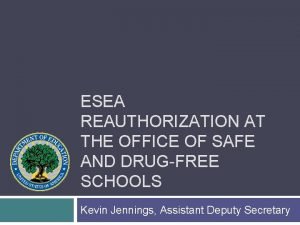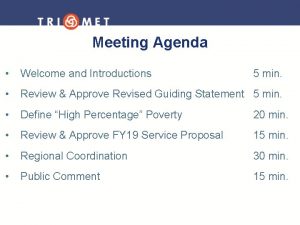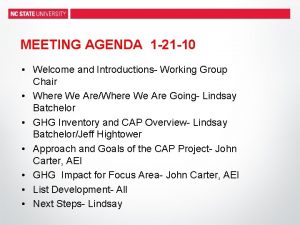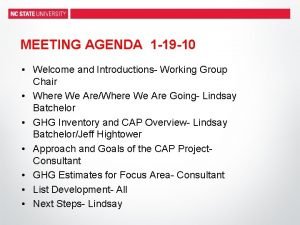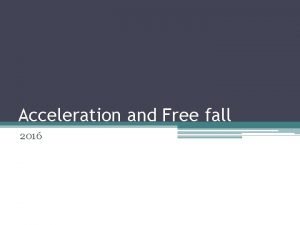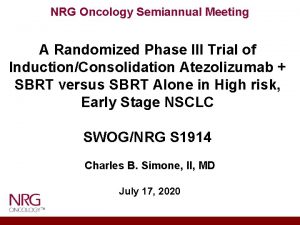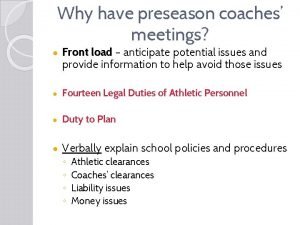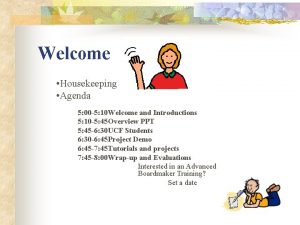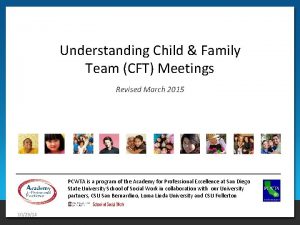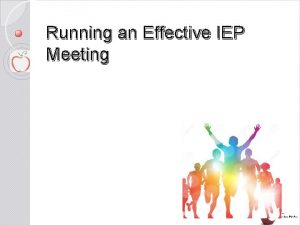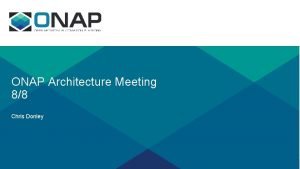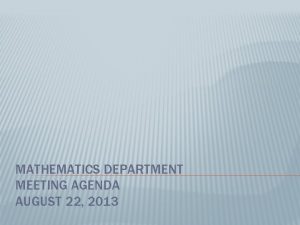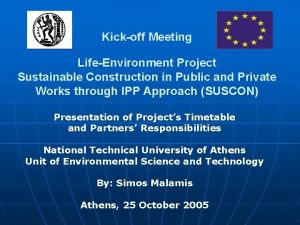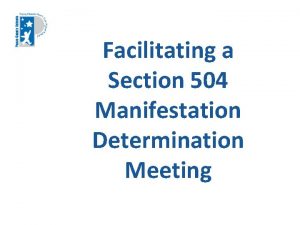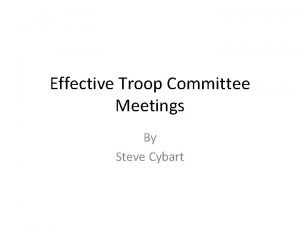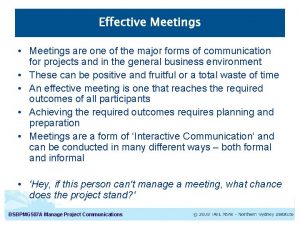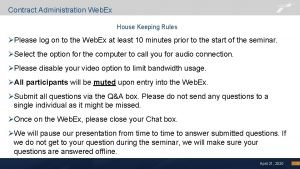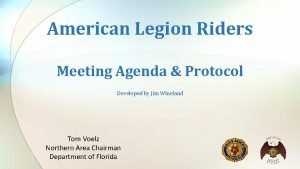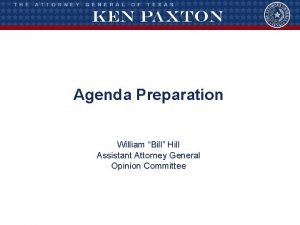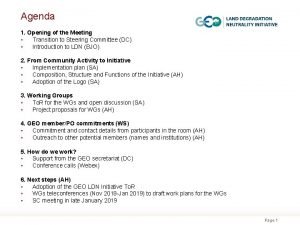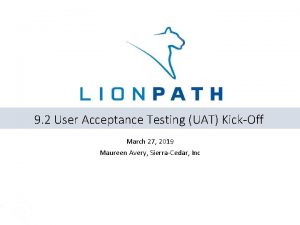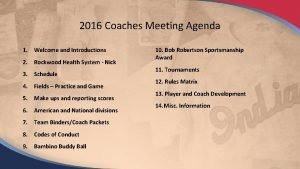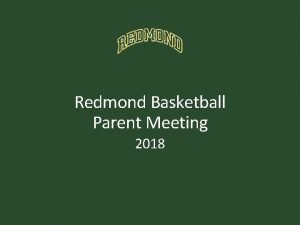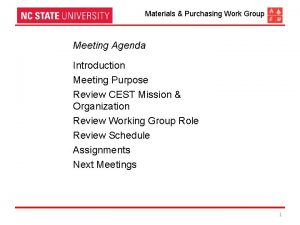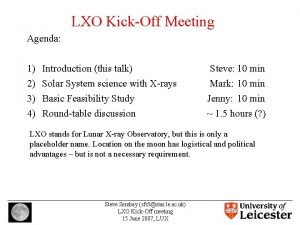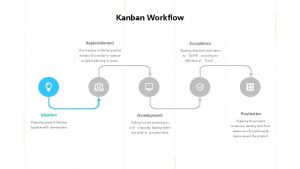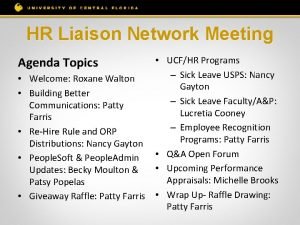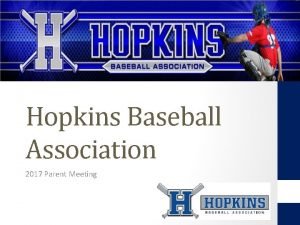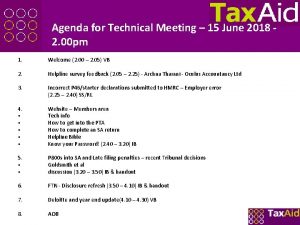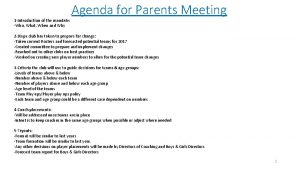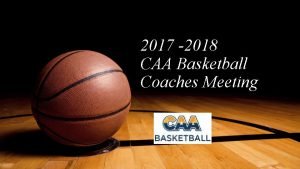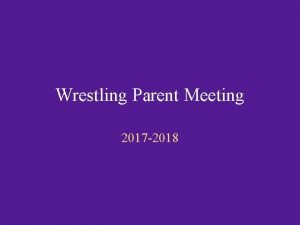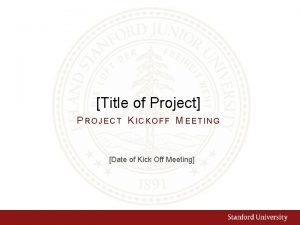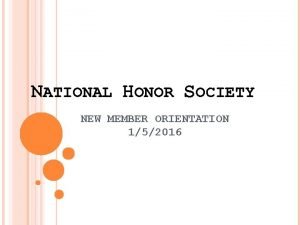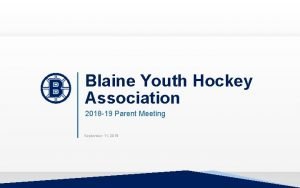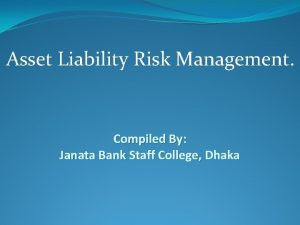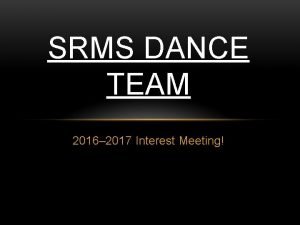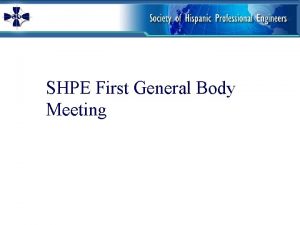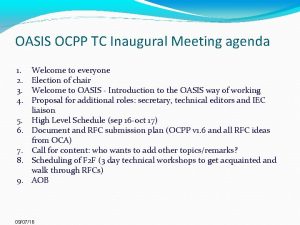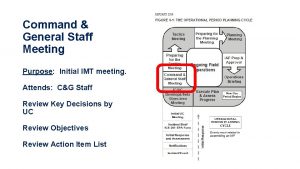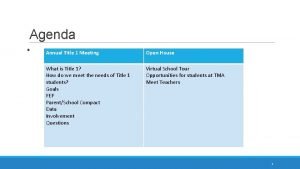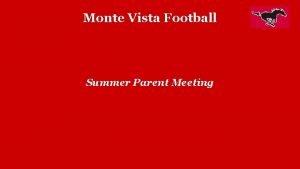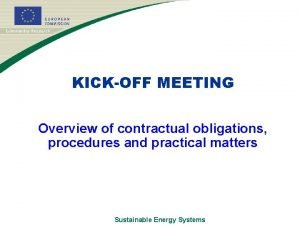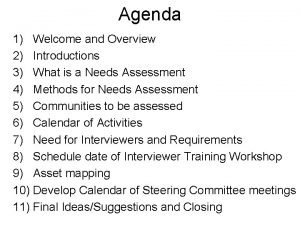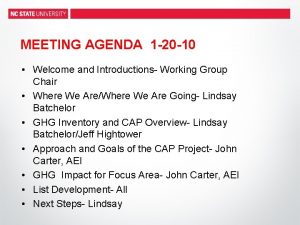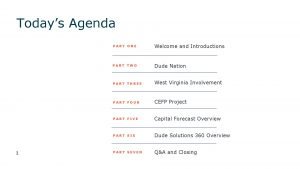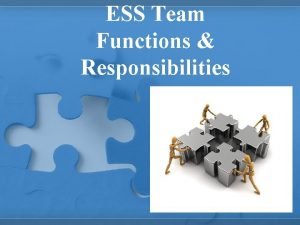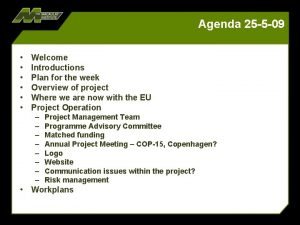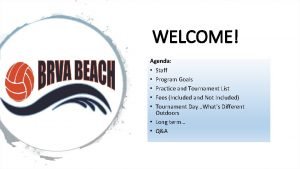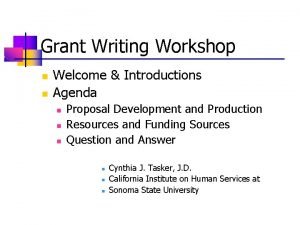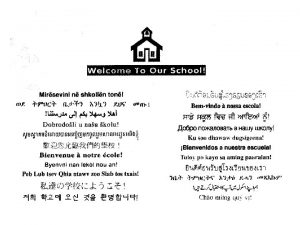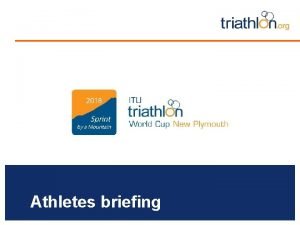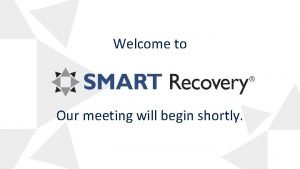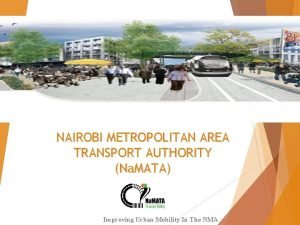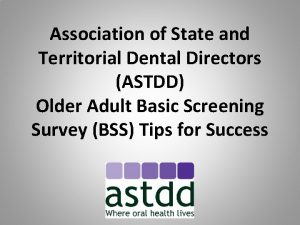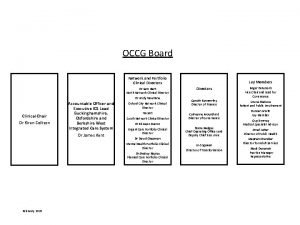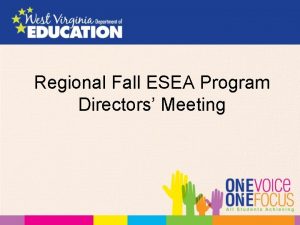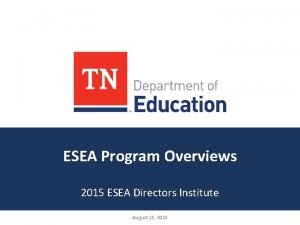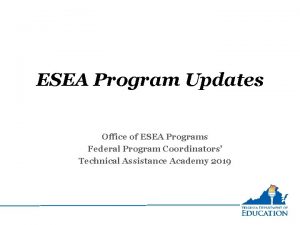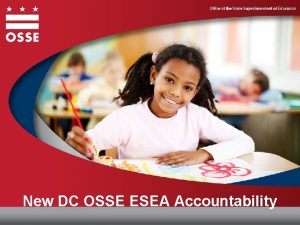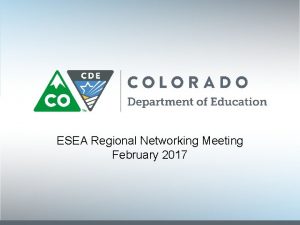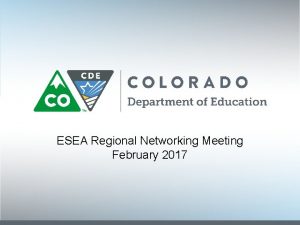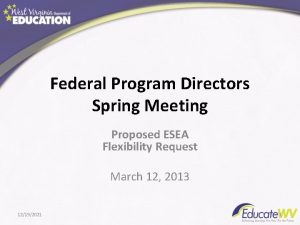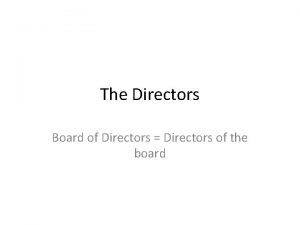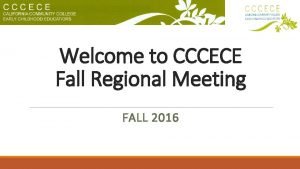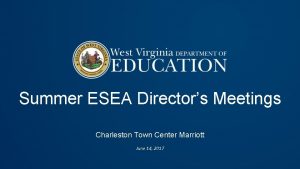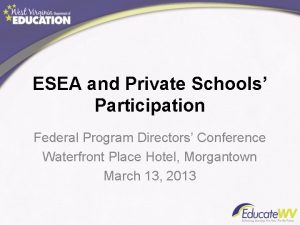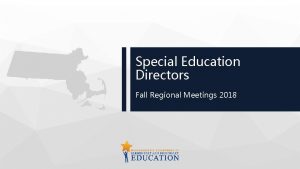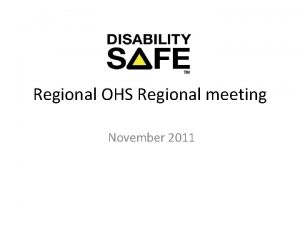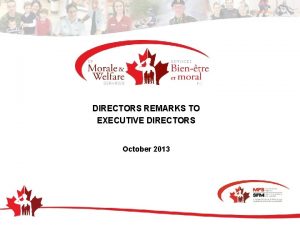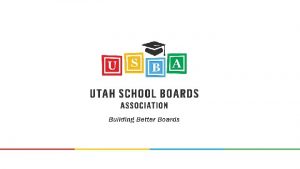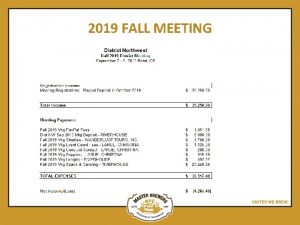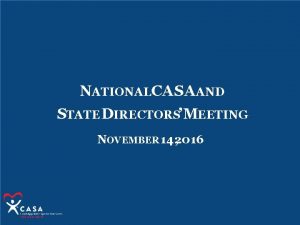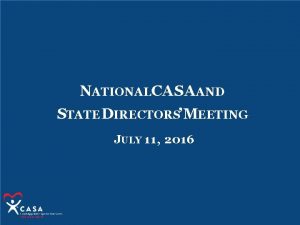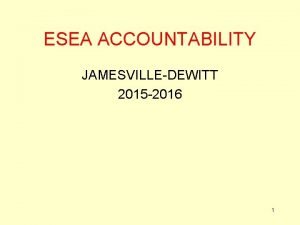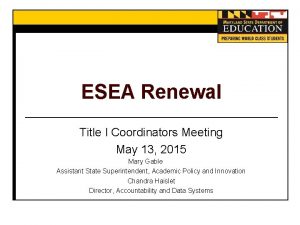ESEA Directors Regional Meeting Fall 2016 Agenda Welcome




































































































- Slides: 100

ESEA Director’s Regional Meeting Fall 2016

Agenda • Welcome & Updates (A-F, Fiscal, Data Management, Grants Management) • Joint Guidance on Educational Stability • ESSA State Plan Development • Title III Program • Refresher for Federal Programs Directors

A-F Update • WVBE November 16, 2016 – Public Release • Focus on Continuous Improvement • Prioritization of Funding to Support Schools with Grades of D or F • ASCD Conference Outcomes

Resources • A-F - http: //mywvschool. org • Teaching - https: //wvde. state. wv. us/apps/tree/ • Improvement http: //wvde. state. wv. us/schoolimprovement/ • Root cause-Strategic Plan Worksheet https: //wveis. k 12. wv. us/

Fiscal Management – ESSA Laura Pauley, CPA lepauley@k 12. wv. us WVDE Office of Federal Programs

Funding Streams under ESSA • Title I - Improving Basic Programs Operated by State and Local Educational Agencies • Title II – Preparing, Training, and Recruiting High-Quality Teachers, Principals, or Other School Leaders • Title III – Language Instruction for English Learners and Immigrant Students • Title IV – 21 st Century Schools • Title V – State Innovation and Local Flexibility

NCLB – Core Academic Subjects Mathematics English Language Arts Science History Civics and Government Geography Foreign Language Arts Economics

Well-Rounded Education Writing Technology Engineering Computer Science Music Career and Technical Health Physical Education

Improving Basic Programs Operated by State and Local Educational Agencies TITLE I

Schoolwide Programs • Supporting School Reform by Leveraging Title I Funds in a Schoolwide Program under ESSA – 40% or more of student living in poverty or waiver

Implementing a Schoolwide Program • Comprehensive needs assessment • Comprehensive schoolwide plan • Annually evaluating the schoolwide plan

Uses of Funds - Schoolwide • Services that facilitate the transition from early learning to elementary education • Recruitment/retention of effective teachers in high-need subjects • Instructional coaches to provide highquality school-based PD • Evidence-based strategies to accelerate content knowledge for EL’s

• Advanced placement, dual/concurrent enrollment programs • CTE programs that prepare students for post secondary education • Counseling, school-based mental health, mentoring • School climate interventions (anti-bullying, positive behavior interventions) • Equip, materials, training to compile and analyze student achievement data

• Response-to-intervention strategies intended to allow for early identification of students with learning or behavioral needs • Devises and software for students to access digital learning materials • Activities that increase family and community engagement (ex. family literacy programs)

TITLE I – COMMON MISUNDERSTANDINGS

• Title I funds may be used only to support reading and math instruction – Title I funds may be used in a schoolwide program to support academic areas that the school’s needs assessment identifies as needing improvement

• Title I funds may by used only to provide remedial instruction – The purpose of a schoolwide program is to upgrade the entire educational program in the school in order to raise the achievement of the lowest-achieving students. This does not need to be achieved through remedial instruction and sometimes includes advanced courses.

• Title I funds may only be used to serve low -achieving students – Funds may be used to upgrade the entire educational program and, in doing so, all students may benefit from the use of funds. However, the reason to upgrade is to improve the achievement of the lowest-achieving students.

• If a school is not consolidating funds , Title I funds may only be used to provide pullout services – Pull-out services are not prohibited but not required.

• Title I funds may be used only for instruction – Title I funds may be used to improve the quality of instructional materials, improve attendance, improve school climate, counteract and prevent bullying, provide counseling, mentoring, school-based mental health services, behavioral supports.

• Title I funds may be not be used to support preschool-aged children – Title I funds may be used to improve cognitive, health and social-emotional outcomes in order to prepare children for success in kindergarten.

Other items to consider • If a schoolwide program school consolidates federal funds, it must maintain records that demonstrate that it meets the intent and purposes of the federal program whose funds are consolidated

Other items to consider • Schoolwide program must receive funds from non-federal sources to provide services that are required by law before using Title I funds (ex. students with disabilities and ELs)

Other items to consider • Federal funds in a schoolwide program must still be used to supplement the amount of funds that would be made available under State and local sources in the absence of Federal funds.

Supplement not Supplant • Current Test: 1. Required to be made available under other federal, state, or local laws 2. Provided with non-federal funds in prior year 3. Provided services to Title I students and the same services were provided to non-Title I students using state or local funds

Supplement not Supplant • New rules for testing SNS for Title I – Expected to begin in 2018 -19 • No longer look at individual costs to determine if supplemental • LEAs must show that each Title I school receives all the state and local funding it would otherwise

New Reporting Requirement • Districts must report the per-pupil expenditures of Federal, State and local funds, including actual personnel and nonpersonnel expenditures for each school

Preparing, Training, and Recruiting High-Quality Teachers, Principals, or Other School Leaders TITLE II

Flow of Title II, Part A Funding Not less than 95% for LEA Sub-grants (ESEA section 2010(c)(1)) NEW: SEA may reserve up to 3% of the amount for LEA sub-grants for Statelevel principal and school leader support Remainder for LEA subgrants Total State Allocation for Title II, Part A (100%) NEW: SEA may reserve up to 2% of total State funding for teacher, principal, or other school leader preparation academies Up to 5% for State Activities Up to 1% of total State funding for State Admin Remainder for other State Activities

Consultation • LEAs are required to: – Meaningfully consult with teachers, principals and other school leaders, paraprofessionals, parents, community partners and other partners with expertise in programs and activities designed to meet the purpose of Title II Part A – Seek advice from stakeholders regarding how to improve Title II activities

• Coordinate with other related strategies, programs or activities in the State or LEA • Provide for equitable participation or private school teachers and other educational personnel in private schools

Historical Uses of Funds • Class-size reduction • Professional development

New uses of funds • Multiple Pathways to Teaching and Leading – Teacher, principal and other school leader academies – Teacher residency programs – Alternative routes to teaching – Reform of preparation standard, certification, licensure and tenure

• Induction and Mentorship • Educator evaluation and support systems • Strong teacher leadership – Flex time for collaborative planning, curriculum writing, peer observations, and leading training – Increased compensation for teachers in leadership roles

• Transformative school leadership – Ongoing professional learning for principals and other school leaders – State-level schools leader set asides

Language Instruction for English Learners and Immigrant Students TITLE III

Supplement not Supplant • Title III funding cannot supplant other Federal, State, and local funds – This provision remains unchanged under ESSA

Provisions moved to Title I • Several provisions in the ESEA regarding ELs have moved from Title III to Title I – EL parental notification regarding LIEPs and related information – Parental participation (e. g. regular parent meetings) – Reporting to the SEA the # and % or ELs achieving English Language proficiency

• LEAs may still use Title III funds for activities that are now under Title I as long as: – Use of funds is consistent with the purpose of Title III and meets “reasonable and necessary” test – Use of funds is supplemental to Title VI and EEOA civil rights obligations – Can demonstrate that it is also using Title III funds to conduct activities required under Title III

• LEAs may now choose to use Title I funds for the LEA EL activities that have been moved from Title III to Title I

Administrative Costs • LEA may use no more than 2% of its Title III funding for administrative costs – Now only applies to direct administrative costs – Indirect costs are no longer included in the 2% limit

Required Uses of Funds • Prior to ESSA Title III required funding to be used for the following two activities: – Professional Development – Providing an LIEP • New requirement added under ESSA – Providing & implementing effective activities and strategies that enhance or supplement LIEPs, which must include parent, family and community engagement.

Student Support and Academic Enrichment (SSAE) TITLE IV, PART A

Newly Authorized Program • Provide students with access to a wellrounded education • Improve school conditions for student learning • Improve the use of technology in order to improve academic achievement and digital literacy of all students

Grants of $30, 000 or more • LEAs that receive a grant of at least $30, 000 must conduct a comprehensive needs assessment and must use funding as follows: – At least 20% to support well-rounded educational opportunities – At least 20% to support safe and healthy students – A portion of funds on effective use of technology • With no more than 15% used for technology infrastructure

Supplement not Supplant • Title IV, Part A funds must be used to supplement and not supplant non-federal funds

Amount of funding • LEAs will receive a sub-grant that will be issued in the same proportion as to the LEAs prior year Title I Part A allocations • Minimum grant of $10, 000

Allowable Activities • Examples include: – Activities to support a well-rounded education • • Science, technology, engineering and mathematics Music and arts Foreign language instruction Accelerated learning programs Dual or concurrent enrollment Civics College and career counseling

• Social emotional learning • Environmental education – Activities to support safe and healthy students • Safe and supportive learning environments • Student physical and mental health – Activities to support effective use of technology • Personalized learning • Blended learning strategies

OTHER CHANGES UNDER ESSA

Maintenance of Effort • New MOE rules for FY 18 funding • LEAs must continue to spend at least 90% of the state and local funds that they spent in the prior year • New flexibility for not meeting MOE for 1 yr – Title I only reduces if the LEA failed MOE more than once in the past five years

Maintenance of Effort • Programs covered under MOE – Title III – Title IV – Title V

Prohibited Use of Funds • ESSA prohibits grant spending funds on the following unless specifically authorized by a program – School construction, renovation or repair – Transportation

Helpful Links • Every Student Succeeds Act – https: //www. gpo. gov/fdsys/pkg/BILLS 114 s 1177 enr/pdf/BILLS-114 s 1177 enr. pdf • Notices of Proposed Rulemaking – https: //www. federalregister. gov/articles/2016/0 5/31/2016 -12451/elementary-and-secondaryeducation-act-of-1965 -as-amended-by-theevery-student-succeeds

• US Ed ESSA Guidance – http: //www 2. ed. gov/policy/elsec/leg/essa/inde x. html

Questions

2 nd Month Certification

2 nd Month Certification • Step 1: Student Edits – Access to student edits is district specific, ask your WVEIS county contact if you should receive these – Work with schools or WVEIS county contact to review and resolve any student edits • Step 2: Review live enrollment – You should work with schools or WVEIS county contact to resolve any issues with enrollment counts • Step 3: Principal will submit • Step 4: Review submitted information • Step 5: Superintendent will submit

2 nd Month Certification - Affects • • • State Aid Funding Student enrollment numbers Percent Needy Public Reporting Data sent to Federal Government

2 nd Month Certification – Title I • Sections you should review depend on your role within your district – Address Information • Thoroughly review your schools’ Title I Flag – Low SES Status • Thoroughly the number of students for each SES code • Child Nutrition Director may assist

2 nd Month Certification – Title III • Sections you should review depend on your role within your district – ELL Status – R District ELL Status – Summer School • If you have students that attended summer school to graduate • Total ELL students 2, 726

2 nd Month Certification – Homeless • Sections you should review depend on your role within your district – Homeless • Total Homeless students 5, 569

2 nd Month Certification Homeless Survey • This year only the Homeless Survey was in 2 nd Month Certification • Beginning this year you will complete homeless survey at end of year • Student counts come from the Homeless Youth and Children (HOME. LESS system)

2 nd Month Certification Discrepancies • Report any discrepancies to your WVEIS County Contact and/or school

Timelines • Percent Needy – Ready for review – Completed by December 2, 2016 – No data changes will be allowed • Comparability Report – Certified Personnel List planned to end November 15, 2016 – Planned to begin December 1, 2016 – Completed by December 31, 2016

School Monitoring Report (SMR) • Federal Program SMR – Accessible through WOW or Portal – School Level • OEPA SMR – District Level

Zoom. WVe ELL Reporting • Title III Dashboard – One placed for Title III reporting • Planned features – General Summative Assessment Scores – ELPA Scores – Student roster with proficiency level – Students being monitored – Accommodations and classroom modifications

Zoom. WVe ELL Reporting • Questions – Screening results – Grades – Attendance • What are your other requirements?

Grants Management System • State RFP for Online ESEA Grant Management System • Opening of Bids -November 15, 2016 • Evaluation & Award – December 2016 • Regional Technical Training – Spring 2017

West Virginia Joint Guidance on Educational Stability for Homeless Children and Children in Foster Care

Agenda • • • ESSA Requirements Overview of WV’s Process Review of Joint Guidance Timelines for Implementation Resources

ESSA Overview • December 10, 2015 signing of the Every Student Succeeds Act • Secretary providing guidance on transitioning from NCLB to ESSA www. ed. gov/essa • Non-Regulatory Guidance: Ensuring Educational Stability for Children in Foster Care

An SEA must ensure that, by December 10, 2016, an LEA receiving Title I funds will collaborate with the State or local child welfare agency to develop and implement clear, written procedures governing how transportation to maintain children in foster care in their schools of origin when in their best interest will be provided, arranged, and funded for the duration of time in foster care, consistent with section 1112(c)(5)(B) of the ESEA.

ESSA also amended section 725 of the Mc. Kinney-Vento Homeless Assistance Act (Mc. Kinney-Vento Act), removing children “awaiting foster care placement” from the definition of “homeless children and youths” for purposes of the Education for Homeless Children and Youths (EHCY) program. This change takes effect for non-covered States on December 10, 2016. Thus, children who are awaiting foster care placement must be served under the Mc. Kinney. Vento Act until at least December 10, 2016. After this date, an SEA and LEA must meet the Title I requirements for children in foster care, including those awaiting foster care placement, regardless of whether the State is a covered or non-covered State.

WV’s Process • WVDE, Office of Federal Programs collaboration with WV DHHR • Ensuring Educational Stability for Children in Foster Care State Plan Meeting – August 16, 2016 • Superintendent Mailing for LEA Contacts – August 26, 2016 • Developed Draft Joint Guidance

West Virginia Draft Joint Guidance • Introduction • Definitions (Foster Care & Homelessness) • Educational Stability Process (BID, Transportation to School of Origin, Immediate Enrollment) • Point of Contacts • Forms

West Virginia Draft Joint Guidance

Timelines for Implementation • Finalize Joint Guidance – November 17, 2016 • Release of Guidance and Local Contacts – November 20, 2016 • Joint Webinar –December 1 & 2, 2016 • LEA Implementation – December 10, 2016

Resources • SEA Point of Contact: Melanie Purkey • Child Welfare Point of Contact: Linda Watts State Website: http: //wvde. state. wv. us/federalprograms/foster-care. html

Questions

ESSA State Plan Development

Plan Components • • Academic Standards and Assessment: states must describe challenging academic standards and assessments that are consistent with the regulations in Section 1111(b)(1) of ESSA. School Accountability and Support for Improvement: states must describe their school accountability system which must include various indicators of student achievement and outcomes. States must also describe its system of support for improving schools that are underperforming and identified by the accountability system to require differentiated supports for improvement. Support for Excellent Educators: states must describe their strategies for recruiting and retaining highly effective educators, providing supports to improve educator effectiveness and assuring that all student have access to highly effective teachers. Support for All Students: states must describe how it will ensure that all students receive a fair, equitable and high quality education with a focus on specific subgroup interventions.

http: //wvde. state. wv. us/essa/

Decision Matrix

Timeline for Development • Final Regulations – December 12, 2016 • Regional Launch Meetings -Morgantown, WV (Waterfront) January 9, 2017 -Charleston, WV (Embassy Suites) January 13, 2017 • Regional Input Meetings – February 2017 • Plan Submission – March 2017

U. S. ED Non-Regulatory Guidance • • Title I, Schoolwide Guidance Title II, Supporting Educators Title III, English Learners Title IV, Student Support & Academic Enrichment • ESSA Early Learning Guidance • Evidence Guidance http: //www 2. ed. gov/policy/elsec/leg/essa/index. html

Non-Regulatory Guidance Review 1. What changes in program implementation do you note? 2. How does the guidance directly impact your individual county LEA plan? (How will it change your practice? ) 3. What questions or unknowns remain?

Title III Program & English Learners

AGENDA • • • ESSA & Policy 2417 Revisions EL Advisory Council EL Accommodation Work Participation Guidelines ELPA 21 Training & Tests Program Services & Resources

Challenging Academic Standards and Academic Assessments • Adopt challenging academic standards, including English language proficiency standards (Section 1111(b)(1)). • English Language Proficiency standards align with the state’s challenging academic standards and address differing proficiency levels of English learners. (Section 1111(b)1)(F)(ii)).

Challenging Academic Standards and Academic Assessments Cont. . • High-quality student academic assessments (Section 1111(b)(2)). - The statewide uniform English language proficiency (ELP) assessment aligns with the state’s ELP standards. - Appropriate accommodations - State’s approach to providing native- language assessments in the non-English languages present to a significant extent in the State’s student population.

Accountability, Support and Improvement for Schools • Ambitious long-term goals and measures of interim progress of English learners in achieving English language proficiency (Section 1111(c)(4)(A) • EL subgroup performance and reporting • N-size and grade levels

Supporting All Students • SEA’s standardized entrance and exit procedures for English learners consistent with Section 3113(b)(2), as amended by ESSA. These procedures must include valid, reliable, and objective criteria that are applied consistently across the State. At a minimum, the standardized exit criteria must: – Include a score of proficient on the State’s annual English language proficiency assessment; – Be the same criteria used for exiting students from the English learner subgroup for Title I reporting and accountability purposes; – Not include performance on an academic content assessment; and – Be consistent with Federal civil rights obligations.

EL Advisory Council • Input for key decision points related to EL portions of ESSA • Accountability Webinar - December 15, 2016 • Council Meeting – January 12, 2017 in Charleston • Revision of Policy 2417

National Center on Educational Outcomes (NCEO) • Improving Instruction of English Learners Through Accessibility Decision Making - 5 –year project through USED OELA - Modules - Improve the understanding of how to select, implement, and evaluate the use of accessibility features and accommodations in instruction and on assessments

Participation Guideline • Participation Guideline Committee meeting: 9/21/2016 • ELPA 21: Assessment Participation Form • Participation Guideline Webinar: 12/16/2016 11 am

ELPA 21 Key Dates Testing Window 2/14/2017 -3/24/2017 • 12/9/2016 – Due date for Pre-ID upload (WVEIS) • 1/3/2017 – Interactive Demo: Go live • 1/10/2016 – Admin Site: Go live • 2/6/2017 – Materials arrive in districts (Material Ordering 2/6/2017 – 3/24/2017)

ELPA 21 Training Dates Testing Window 2/14/2017 -3/24/2017 • 12/8/2016 2 pm – ELPA 21 Kick Off Training • 12/15/2016 2 pm – System Readiness Training • 1/19/2017 2 pm – Test Preparation, Admin Roles & Functionality training

Program Services & Resources • Academic Language Webinar https: //vimeo. com/185315629 • Newcomer toolkit http: //www 2. ed. gov/about/offices/list/oela/ne wcomers-toolkit/index. html

Questions? Robert Crawford, Assistant Director (rcrawford@k 12. wv. us) Mami Itamochi, Coorinator (mitamochi@k 12. wv. us) WV Department of Education: Office of Federal Program 304 -558 -7805
 Is esea safe
Is esea safe Meeting agenda welcome and introductions
Meeting agenda welcome and introductions Meeting agenda welcome and introductions
Meeting agenda welcome and introductions Meeting agenda welcome and introductions
Meeting agenda welcome and introductions Meeting agenda welcome and introductions
Meeting agenda welcome and introductions Welcome 2 directors
Welcome 2 directors Martech 2016 agenda
Martech 2016 agenda Agenda sistemica y agenda institucional
Agenda sistemica y agenda institucional Free fall 2016
Free fall 2016 Nrg oncology meeting 2019
Nrg oncology meeting 2019 Nrg virtual meeting
Nrg virtual meeting Nrg oncology semiannual meeting
Nrg oncology semiannual meeting Preseason coaches meeting agenda
Preseason coaches meeting agenda Housekeeping meeting agenda
Housekeeping meeting agenda Football meeting agenda
Football meeting agenda Cft meeting in company
Cft meeting in company Meeting objective
Meeting objective Graduation meeting agenda
Graduation meeting agenda Iep meeting agenda
Iep meeting agenda Close out project
Close out project Channel partner meeting agenda
Channel partner meeting agenda Architecture meeting agenda
Architecture meeting agenda Mentor meeting agenda
Mentor meeting agenda Math department meeting agenda
Math department meeting agenda Kick off meeting agenda for construction project
Kick off meeting agenda for construction project Iep meeting agenda
Iep meeting agenda The agenda communicates important information such as
The agenda communicates important information such as Manifestation meeting for 504
Manifestation meeting for 504 Boy scout troop committee organization chart
Boy scout troop committee organization chart Steering committee meeting agenda sample
Steering committee meeting agenda sample Pre construction meeting agenda example
Pre construction meeting agenda example Architecture meeting agenda
Architecture meeting agenda American legion meeting agenda
American legion meeting agenda Accounting meeting agenda
Accounting meeting agenda Transition meeting agenda
Transition meeting agenda Uat kickoff ppt
Uat kickoff ppt Bob gecewich
Bob gecewich Football coaches meeting agenda
Football coaches meeting agenda Coach /parent meeting agenda
Coach /parent meeting agenda Purchasing meeting agenda
Purchasing meeting agenda Proposal kickoff meeting agenda
Proposal kickoff meeting agenda Kanban replenishment meeting agenda
Kanban replenishment meeting agenda Hr meeting agenda topics
Hr meeting agenda topics Pitch 2 pitch chanhassen
Pitch 2 pitch chanhassen Graduation meeting agenda
Graduation meeting agenda Baseball parent meeting agenda
Baseball parent meeting agenda Breakfast meeting agenda
Breakfast meeting agenda Technical meeting agenda
Technical meeting agenda Agenda for parents meeting
Agenda for parents meeting High school coaches meeting agenda
High school coaches meeting agenda Wrestling parent meeting agenda
Wrestling parent meeting agenda Meeting agenda visio
Meeting agenda visio Class meeting agenda
Class meeting agenda Cheerleading parent meeting agenda
Cheerleading parent meeting agenda Prior lake wrestling schedule
Prior lake wrestling schedule Distributor meeting agenda
Distributor meeting agenda National honor society meeting agenda
National honor society meeting agenda Blaine youth hockey
Blaine youth hockey Alco meeting agenda
Alco meeting agenda Validation meeting agenda
Validation meeting agenda Interest meeting agenda
Interest meeting agenda Shpe agenda
Shpe agenda Volleyball parent meeting agenda
Volleyball parent meeting agenda Inaugural meeting agenda
Inaugural meeting agenda General staff meeting
General staff meeting Title 1 meeting agenda
Title 1 meeting agenda Student council meeting agenda
Student council meeting agenda Meeting agenda
Meeting agenda Vista
Vista Product roadmap meeting agenda
Product roadmap meeting agenda Audit kick off meeting agenda
Audit kick off meeting agenda Agenda welcome and introductions
Agenda welcome and introductions Agenda welcome and introductions
Agenda welcome and introductions Agenda welcome
Agenda welcome Agenda welcome and introductions
Agenda welcome and introductions Welcome session agenda
Welcome session agenda Agenda welcome and introductions
Agenda welcome and introductions Welcome agenda
Welcome agenda Agenda welcome and introductions
Agenda welcome and introductions Parent orientation agenda
Parent orientation agenda Agenda welcome and introductions
Agenda welcome and introductions Agenda welcome and introductions
Agenda welcome and introductions Today meeting or today's meeting
Today meeting or today's meeting What is meeting and types of meeting
What is meeting and types of meeting What is meeting and types of meeting
What is meeting and types of meeting Welcome to our first meeting
Welcome to our first meeting Habr
Habr Meeting will begin shortly
Meeting will begin shortly Coincide meaning
Coincide meaning Welcome welcome this is our christmas story
Welcome welcome this is our christmas story Annulene aromaticity
Annulene aromaticity Cyber security board presentation ppt
Cyber security board presentation ppt Namata board of directors
Namata board of directors Directors brief
Directors brief Jmh board of directors
Jmh board of directors Directors emma wolverson
Directors emma wolverson Compliance presentation to board
Compliance presentation to board Board advisory services
Board advisory services Astdd
Astdd German expressionist directors
German expressionist directors Clinical directors network
Clinical directors network
